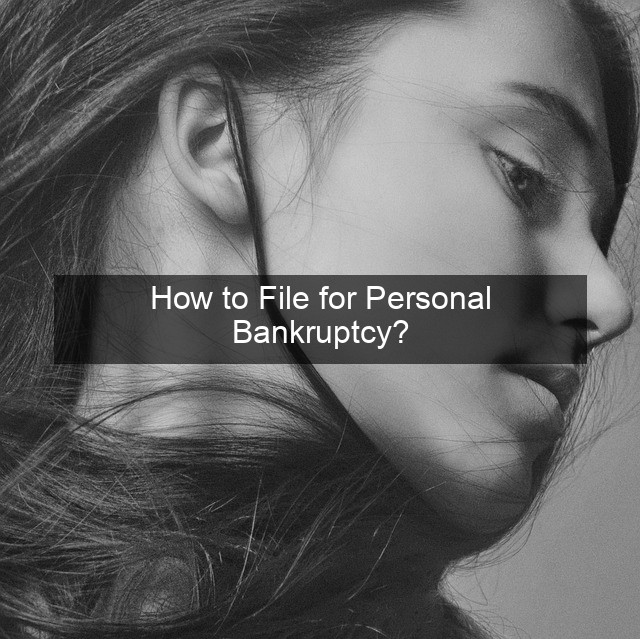How to File for Personal Bankruptcy?
- How to File for Personal Bankruptcy?
- Understanding the Different Types of Bankruptcy
- Chapter 7 Bankruptcy: Liquidation
- Chapter 13 Bankruptcy: Reorganization
- Preparing for Bankruptcy
- Gathering Necessary Documentation
- Credit Counseling Requirements
- Choosing a Bankruptcy Attorney
- Filing Your Bankruptcy Petition
- Completing the Bankruptcy Forms
- Filing Fees and Payment Options
- Meeting with the Trustee
- Life After Bankruptcy
- Rebuilding Your Credit
- Financial Planning for the Future
- Frequently Asked Questions (FAQ)
- Common Bankruptcy Questions

Navigating the Process: How to File for Personal Bankruptcy
Facing insurmountable debt can be an incredibly stressful experience. It can feel like you’re drowning in financial obligations, with no clear path to shore. Personal bankruptcy can offer a lifeline, providing a legal process to manage overwhelming debt and gain a fresh financial start. However, the decision to file for bankruptcy is a significant one, with long-term implications. Understanding the process and its complexities is crucial before taking this step. This comprehensive guide will walk you through the steps involved in filing for personal bankruptcy, providing you with the knowledge you need to navigate this challenging but potentially liberating process.
Understanding the Different Types of Bankruptcy
Chapter 7 Bankruptcy: Liquidation
Chapter 7 bankruptcy, often referred to as liquidation bankruptcy, involves the sale of non-exempt assets to repay creditors. This type of bankruptcy is generally best suited for individuals with limited income and few assets. It provides a relatively quick discharge of most unsecured debts, such as credit card debt and medical bills.
The process begins with filing a petition with the bankruptcy court. A trustee is then appointed to oversee the process and liquidate any non-exempt assets. The proceeds from the sale are distributed to creditors according to the bankruptcy code’s priority scheme.
While Chapter 7 bankruptcy can offer a fresh start, it’s essential to understand that certain debts, such as student loans and child support, are typically not dischargeable.
Chapter 13 Bankruptcy: Reorganization
Chapter 13 bankruptcy, also known as reorganization bankruptcy, allows individuals with regular income to create a repayment plan over a period of three to five years. This option is generally chosen by individuals who want to keep their assets, such as a house or car, and have the ability to repay a portion of their debt.
Under a Chapter 13 bankruptcy, the debtor proposes a repayment plan to the court, outlining how they will repay their creditors over the designated period. The plan must be approved by the court and must provide for the payment of certain priority debts, such as taxes and secured debts.
Chapter 13 bankruptcy can be a viable option for individuals who have a stable income and want to avoid the liquidation of their assets.
Preparing for Bankruptcy
Gathering Necessary Documentation
Before filing for bankruptcy, it’s essential to gather all necessary financial documentation. This includes recent tax returns, pay stubs, bank statements, credit card statements, and loan documents. Having this information readily available will streamline the filing process and ensure accuracy.
Organizing your financial records is a crucial first step. Create a comprehensive list of your assets, liabilities, income, and expenses. This will provide a clear picture of your financial situation and help you determine the best course of action.
Accurate and complete documentation is critical for a successful bankruptcy filing. Take the time to gather all necessary paperwork before proceeding.
Credit Counseling Requirements
Before filing for bankruptcy, you are required to complete a credit counseling course from an approved agency. This course provides information on budgeting, debt management, and alternative solutions to bankruptcy.
The purpose of credit counseling is to explore all available options before resorting to bankruptcy. The counselor will help you assess your financial situation and determine if bankruptcy is the most appropriate solution.
You must receive a certificate of completion from the credit counseling agency before filing your bankruptcy petition.
Choosing a Bankruptcy Attorney
While it’s possible to file for bankruptcy without an attorney, it’s highly recommended to seek legal counsel. A qualified bankruptcy attorney can guide you through the complex legal process and ensure your rights are protected.
An attorney can help you determine the best type of bankruptcy for your situation, prepare and file the necessary paperwork, and represent you in court.
Choosing an experienced bankruptcy attorney can significantly increase your chances of a successful outcome.
Filing Your Bankruptcy Petition
Completing the Bankruptcy Forms
Filing for bankruptcy involves completing a series of official forms. These forms require detailed information about your assets, liabilities, income, and expenses. Accuracy is paramount, as any errors or omissions can delay the process or even lead to your case being dismissed.
The bankruptcy forms can be complex and confusing. An attorney can help you understand the requirements and ensure you complete the forms correctly.
Take your time and carefully review all information before submitting your bankruptcy petition.
Filing Fees and Payment Options
There are filing fees associated with bankruptcy, which vary depending on the type of bankruptcy you file. If you cannot afford the filing fees, you may be able to request a fee waiver.
The court offers payment plans for those who cannot afford to pay the fees upfront. Discuss your options with the court clerk or your attorney.
Understanding the fee structure and payment options can help you budget accordingly.
Meeting with the Trustee
After filing your bankruptcy petition, you will be required to attend a meeting with the trustee. This meeting, known as the 341 meeting of creditors, allows the trustee and creditors to ask you questions about your finances and the information provided in your bankruptcy petition.
Be prepared to answer questions truthfully and accurately. Your attorney can accompany you to the meeting and provide guidance.
The trustee’s meeting is an essential part of the bankruptcy process.
Life After Bankruptcy
Rebuilding Your Credit
Bankruptcy will negatively impact your credit score. However, you can begin rebuilding your credit after the bankruptcy is discharged. This involves paying bills on time, maintaining a low credit utilization ratio, and avoiding new debt.
Rebuilding credit takes time and effort. Be patient and consistent with your financial habits.
A secured credit card can be a helpful tool for rebuilding credit after bankruptcy.
Financial Planning for the Future
Bankruptcy provides an opportunity for a fresh financial start. Take advantage of this opportunity by creating a budget, saving for emergencies, and making informed financial decisions.
Seek financial counseling if needed. A financial advisor can help you develop a long-term financial plan.
Learning from past financial mistakes is crucial for future financial success.
Frequently Asked Questions (FAQ)
Common Bankruptcy Questions
- How long does bankruptcy stay on my credit report? Chapter 7 bankruptcy typically remains on your credit report for 10 years, while Chapter 13 bankruptcy remains for 7 years.
- Will I lose everything I own if I file for bankruptcy? Not necessarily. Certain assets are exempt from liquidation, depending on state law.
- Can I file for bankruptcy more than once? Yes, but there are waiting periods between filings.
- How much does it cost to file for bankruptcy? The cost varies depending on the chapter you file and attorney fees.
- What are the alternatives to bankruptcy? Alternatives include debt consolidation, debt settlement, and credit counseling.
| Bankruptcy Chapter | Description | Typical Duration |
|---|---|---|
| Chapter 7 | Liquidation of non-exempt assets | 3-6 months |
| Chapter 13 | Repayment plan over 3-5 years | 3-5 years |
External Resources:
Conclusion
Filing for personal bankruptcy is a complex legal process with lasting consequences. It’s essential to carefully consider all your options and seek professional guidance before making this decision. This guide has provided a comprehensive overview of the bankruptcy process, from understanding the different types of bankruptcy to rebuilding your credit after discharge. Remember, bankruptcy



